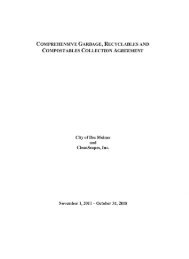CITY OF DES MOINES SHORELINE MASTER PROGRAM
CITY OF DES MOINES SHORELINE MASTER PROGRAM
CITY OF DES MOINES SHORELINE MASTER PROGRAM
Create successful ePaper yourself
Turn your PDF publications into a flip-book with our unique Google optimized e-Paper software.
Des Moines Shoreline Master Program<br />
Shorelines 1 . All of the water areas of the state, including reservoirs, and their associated<br />
shorelands, together with the lands underlying them; except (i) shorelines of statewide<br />
significance; (ii) shorelines on segments of streams upstream of a point where the mean annual<br />
flow is twenty cubic feet per second or less and the wetlands associated with such upstream<br />
segments; and (iii) shorelines on lakes less than twenty acres in size and wetlands associated<br />
with such small lakes.<br />
Shorelines of Statewide Significance 2 . Those areas of Puget Sound in the City of Des Moines<br />
lying seaward from the line of extreme low tide.<br />
Shor elines of the state 1 . The total of all “shorelines” and “shorelines of statewide significance”<br />
within the City of Des Moines.<br />
Should 1 . Indicates the particular action is required unless there is a demonstrated, compelling<br />
reason, based on policy of the SMA and the Des Moines SMP, against taking the action.<br />
Significant vegetation removal 1 . The removal or alteration of trees, shrubs, and/or ground cover<br />
by clearing, grading, cutting, burning, chemical means, or other activity that causes significant<br />
ecological impacts to functions provided by such vegetation. The removal of invasive or noxious<br />
weeds does not constitute significant vegetation removal. Tree pruning, not including tree<br />
topping where it does not affect ecological functions, does not constitute significant vegetation<br />
removal.<br />
Special environmental study 3 . A technical report prepared by a qualified professional. Special<br />
environmental studies are intended to evaluate past and present environmental conditions of<br />
certain properties, potential environmental impacts associated with certain development<br />
proposals, and as appropriate, recommend mitigation measures that can be expected to lessen the<br />
severity of identified adverse environmental impacts. The content and scope of required special<br />
environmental studies shall be as specified by the community development director.<br />
Stream corridor 3 . A perennial, intermittent, or ephemeral stream including its channel bottom,<br />
lower and upper banks, area beyond the top of the upper bank which influences the stream and is<br />
influenced by the presence of water, and the vegetation inhabiting this area. This area is known<br />
as the “riparian zone” which is an area transitional between aquatic and terrestrial (upland)<br />
ecosystems having distinct vegetation and soil characteristics. Riparian zones are most<br />
commonly recognized by bottomland, flood plain, and streambank vegetation. In developed<br />
watersheds, portions of the stream corridor may currently be in a partially culverted or<br />
channelized condition by artificial conveyance systems.<br />
Streambed 2 . The channel of a river or other watercourse and adjacent land areas that are<br />
inundated with flood waters during a 100-year flood.<br />
Structure 1 . A permanent or temporary edifice or building, or any piece of work artificially built<br />
or composed of parts joined together in some definite manner, whether installed on, above, or<br />
below the surface of the ground or water, except for vessels.<br />
KEY: 1. RCW or WAC 2. 1988 SMP Glossary 3. City Zoning Code 4. New Definition<br />
Department of Ecology approval effective November 1, 2010<br />
Adopted by City of Des Moines Ordinance No. 1502 129



